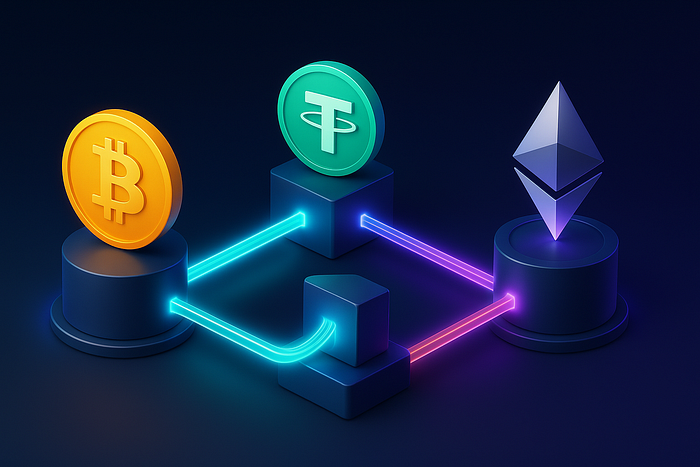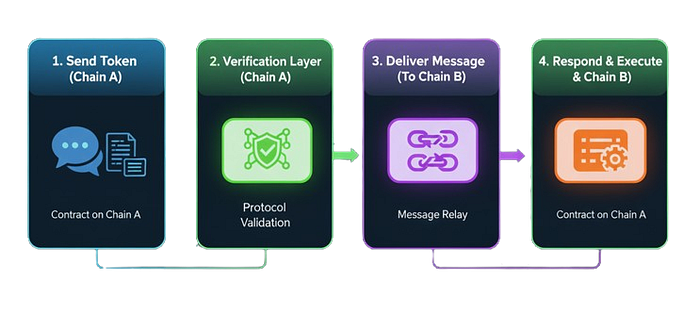How Blockchains Talk to Each Other: Cross-Chain & Interoperability Explained

The “Island Problem” of Early Web3
Imagine a world where you could only email people using the same email provider as you: Gmail users could only talk to other Gmail users, and Outlook users were totally isolated. That was the early blockchain world.
Each blockchain, like Ethereum, Bitcoin, or Solana, was its own secured, powerful island. They all had unique strengths (security, speed, low cost, specialized features) but couldn’t talk to each other. Your valuable tokens and data were fragmented and siloed on their native chains.
Blockchain Interoperability is the essential technology that solves this. It’s the ability of two or more independent blockchain networks to securely exchange information, assets, and value without needing a central intermediary. It’s what transforms a collection of isolated islands into a single, cohesive internet of blockchains.
Why It Matters That Chains Can Communicate
Sure, it’s cool from a tech point of view but why does it actually matter
Unlocking Capital That’s Been Trapped
Here’s the simple truth: there’s a lot of value just sitting around, unable to move freely.
Bitcoin, for example, has over half a trillion dollars locked into its network, but you can’t use that value natively in Ethereum based DeFi. That’s a problem.
With interoperability, that value becomes liquid across ecosystems. You could use your BTC to earn yield on Ethereum, or shift your stablecoins to cheaper networks during periods of high congestion. That mobility means more opportunity for users and better efficiency across the board.
Using the Best Features of Each Chain
Every blockchain was built with different trade offs. Bitcoin is rock solid for security. Ethereum is all about programmability. Layer 2s are built for speed and low fees.
Right now, developers often have to pick one and live with the limitations. But what if they didn’t have to choose What if they could combine those strengths
That’s the magic of interoperability. An app can run fast interactions on a low cost chain, but still rely on Ethereum to finalize important transactions. You don’t have to compromise because chains can work together.
Making Web3 Less Confusing for Regular People
Let’s be honest: using Web3 today isn’t easy. You need to know which chain you’re on, whether your wallet supports it, what gas token to use, and how to bridge assets. For everyday users, that’s overwhelming.
Interoperability helps change that. Apps can handle the routing and complexity behind the scenes. Eventually, users won’t even need to know which chain they are using just like you don’t think about which servers your Netflix stream travels through. Things will “just work.”
How Chains Are Learning to Communicate
There are a few main ways that interoperability is being tackled right now. Some are focused on moving assets, others on passing data or building cross chain ecosystems.
Let’s look at the three most common models.
1. Bridges: Moving Tokens Between Chains
The most widely used solution today is the cross chain bridge. These tools are designed to move tokens from one chain to another. But since blockchains can’t actually transfer tokens natively, bridges use a clever workaround.
Here’s the general process:
- You send your token to a smart contract on Chain A.
- That contract locks up the token.
- A copy of that token, often called a wrapped version, is created on Chain B.
- If you want to return, the wrapped token is burned and the original is unlocked.
It’s similar to putting money in a safe and getting a receipt on another network. The receipt lets you use your funds elsewhere, but the original never actually leaves its vault.
The tricky part is trust. These systems rely on validators or bridge protocols to verify that tokens are locked before creating wrapped versions. If something goes wrong with that process, the whole bridge becomes vulnerable.

2. General Message Passing: More Than Just Tokens
Interoperability isn’t only about moving coins. It’s about sending instructions across chains. That’s where General Message Passing (GMP) comes in.
Imagine Chain A wants Chain B to do something, run a function, release funds, cast a vote, and so on. GMP protocols make this possible by letting smart contracts talk to each other across networks.
Here’s how it generally works:
A contract on Chain A emits a message.
A verification layer checks that it’s legit.
The message is delivered to Chain B, where a contract responds.
Projects like LayerZero, Wormhole, and Axelar are pushing this forward. They allow developers to build apps that span multiple chains but behave like one cohesive system.
Think of it as a group chat between smart contracts that live on different networks.

3. Ecosystems Designed for Interoperability from Day One
Some projects have taken a different approach. They built interoperability into their foundations.
Cosmos and Polkadot are two great examples.
Cosmos uses a system called IBC (Inter Blockchain Communication), which lets chains talk to each other natively.
Polkadot relies on a central Relay Chain, which coordinates activity between connected parachains.
In both cases, the chains involved follow shared standards, which makes communication smoother and often more secure. Instead of patching bridges between independent blockchains, these ecosystems build a network of chains that are meant to work together from the start.
What It Looks Like in Code
Even though cross chain communication is complex under the hood, smart contract developers often work with pretty clean interfaces.
Here’s a simplified Solidity example that sends a message from one chain to another using a router:
contract SenderContract {
address immutable router;
constructor(address _router) {
router = _router;
}
function sendMessage(
uint256 destChainId,
address targetContract,
string memory message
) public payable {
bytes memory payload = abi.encodePacked(message, msg.sender);
(bool success, ) = router.call{value: msg.value}(
abi.encodeWithSignature(
"sendMessage(uint256,address,bytes)",
destChainId,
targetContract,
payload
)
);
require(success, "Message send failed.");
}
}Once the function runs, the router emits an event. Relayers see that event, grab proof that it happened, and deliver it to the destination chain. The receiving contract verifies the message and executes the logic.
It’s kind of like a cross chain API call, but with way more cryptography behind it.
What Makes Interoperability Risky
As powerful as interoperability is, it brings some serious security concerns. Some of the biggest hacks in crypto history involved cross chain bridges.
Here’s why:
Bridges often rely on multisig wallets or external validators. If those keys are compromised, locked funds can be drained.
Smart contracts that interact with multiple chains are more complex, and more complexity means more room for mistakes.
Chains finalize transactions at different speeds. That mismatch can be exploited for double spends or other attacks.
The good news is that the space is evolving. There’s a big push toward trust minimized designs that rely less on external actors and more on cryptographic proof.
We’re seeing innovations like:
Zero knowledge proofs for verifying messages.
Light clients that check blockchain state directly.
These are promising steps, but it’s still an arms race. As cross chain systems grow, so does their attack surface.
Wrapping It All Up: A More Connected Blockchain World
Interoperability isn’t just another technical feature. It’s the key to unlocking blockchain’s full potential.
It means no more fragmented liquidity. It means dApps that work across chains without weird limitations. And most importantly, it means giving users a Web3 experience that feels as seamless as using a modern app.
The future isn’t about one blockchain ruling them all. It’s about many chains working together, each doing what it does best while contributing to a shared network of value.
Just like people stopped thinking about how emails or websites actually travel across the internet, blockchain users will eventually stop worrying about chains, gas tokens, or bridges. They will just use the apps they want and everything will work in the background.
That’s the vision interoperability is bringing closer every day.
Have questions or ideas?
Contact us at: hello@ancilar.com
explore more: www.ancilar.com
Listen To The Article

Black Friday 30%
Offer









